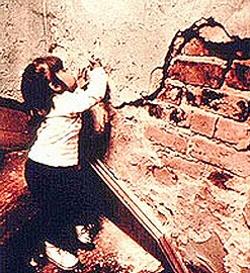 美國紐約州原本打算立法,設立孩童鉛中毒基本預防機制、安全住宅建設基金,並針對降低鉛危害的活動提供營業稅額減免。然而,兩項系列法案16日遭到州長派特森(David Paterson)否決。
美國紐約州原本打算立法,設立孩童鉛中毒基本預防機制、安全住宅建設基金,並針對降低鉛危害的活動提供營業稅額減免。然而,兩項系列法案16日遭到州長派特森(David Paterson)否決。
這兩項法案預計在兩年內花費約5,000萬美元,評論家認為此舉可能為該州吃緊的財政狀況投下深遠、形成日後資金缺口的不利影響。派特森心痛地說,保護孩童免於鉛中毒是他從政多年的重要理念,但預算吃緊使他不得不否決這些措施。
派特森說:「在過去的幾月內,本州的財政危機迫使我必須否決許多法案。那些提議對於立法部門與其選民而言,都是至關重要且非常有價值的。但是,否決這兩項法案讓我倍感痛苦。」 他說:「鉛中毒是困擾並破壞許多孩童生活的災害,剝奪了多數受創孩童生活各方面的權利。20年多年來,我一直是這個議題的倡議者。針對災害作出回應應該是政府每位官員的義務。」
吸入工作場所的空氣或者灰塵,吃到污染的食品,或者飲用了受污染的水,都會使人暴露於鉛中毒的環境中。孩子可能因吃進含鉛的塗料碎片,或在受污染的土地上玩耍而受到污染。鉛會損壞人類神經系統、腎臟和生殖系統。在1978年,油漆中已禁止添加鉛,但舊的建物仍然使用含鉛的油漆。
州長保證將與該法案提案人共同合作,採用花費較少的方式來達成他們的目標,並且允諾在12月18日討論執行預算時,提出這項提議。
派特森正在考慮︰
- 修改法規。不再使用現行每公升20微克(mcg / dL)的標準,當孩童血中含鉛量超過每分升15微克(mcg/dL)時,將啟動全面性干預措施,針對孩童進行後續追蹤。衛生部也將重新檢討可取得的科學研究和數據,以決定該州是否應該更進一步將全面性干預的門檻下修到每公升10微克(mcg / dL)。
- 再次提交衛生部立法提案。該提案將連結該州的免疫登記記錄,並對血中含鉛量上升的孩子進行登錄,提倡由執業醫師進行及時鉛含量篩選,並且改進該州衛生部調查篩選比率的能力。
- 預計於年底前重新審視孩童鉛中毒基本預防計畫的評估結果。這些結果將協助確認有效的地方政策和慣例,彰顯其對於制定未來鉛中毒預防措施的價值。此外,州長將提出相關法令的修正案,以確保這項試驗性計畫能永久執行。
如今,在孩童鉛中毒基本預防計畫中,該州衛生部需要替孩子進行鉛中毒篩檢,並對於血中含鉛量超過每公升10微克(mcg/dl)的孩童進行後續的追蹤檢測,施實降低危害教育和營養的咨詢等。
每位血中含鉛量超過每公升20微克(mcg/dL)的孩童則將接受完整的診斷評估,包括一次詳細的鉛暴露程度評估、營養評估,和發展篩選,隨後並引介適當的地方政府或州政府的衛生單位進行綜合性干預追蹤,包括環境檢查和鉛危險因子的控制。
環保署並對全國每一個血中含鉛量升高的孩子進行登記。
這個計畫需要地方政府與聯邦政府機關在各方面的協調,包括鉛中毒預防、偵測、減少危險性活動,以及公共教育和社區擴大服務計畫。
10月15日,美國環保署已將空氣中含鉛容值調降至原本的十分之。該修訂標準預計將改善曝險群體的健康防護情形,特別是孩童。關於監控不足的問題已被國家空氣品質管理部門和民主黨眾議員提出。
環保署說,每一天全美約有849個孩子鉛中毒。
New York Governor David Paterson Thursday vetoed two bills that would have established a childhood lead poisoning primary prevention and safe housing fund and also given a corporate tax credit for lead hazard reduction activities.
The bills would have cost approximately $50 million over a two year period, which critics said would have had an enormous, unfunded and unplanned impact on the state's stressed finances.
The governor said it was the tight budget situation that made it necessary for him to veto measures that would protect children from lead poisoning, a cause he says has been important to him for years.
"Over the last several months, I have been compelled to disapprove many bills as a direct consequence of the state's fiscal crisis," said Paterson. "A great number of those proposals were very worthy initiatives of great importance to legislators and their constituents. However, no bill pains me more to veto than this measure."
"Lead poisoning is a scourge that has plagued and destroyed the lives of too many children, the vast majority of whom live lives deprived in too many ways," he said. "I have been a vocal proponent for addressing this issue for more than two decades. Responding to this plague is and should be an obligation for everyone in government."
Exposure to lead can happen from breathing workplace air or dust, eating contaminated foods, or drinking contaminated water. Children can be exposed from eating lead-based paint chips or playing in contaminated soil. Lead can damage the human nervous system, kidneys, and reproductive system. Lead in paint was banned in 1978, but older buildings still contain lead-based paint.
The governor pledged to work with this bill's sponsors to achieve their objectives in less costly ways and promised to make such a proposal in the Executive Budget which will be presented on December 18.
Paterson said he is considering:
- Revising regulations so that comprehensive follow-up interventions for children will be triggered when a child has a blood lead level of 15 micrograms per deciliter (mcg/dL) instead of the current level of 20 mcg/dL. The Department of Health will also review available scientific research and data to determine if the state should further revise the threshold for comprehensive interventions to 10 mcg/dL.
- Resubmitting a Department of Health legislative proposal that would link the statewide immunization registry and the statewide registry of children with elevated blood lead levels, promoting timely lead screening by practitioners and improving the state health agency's ability to survey screening rates.
- Reviewing the results of the evaluation of the Childhood Lead Primary Prevention Program, which are expected by the end of the year. These results will help identify effective local policies and practices, which should be of value in designing future local lead poisoning prevention efforts. In addition, the governor will propose a statutory change to make sure that the program, now known as a pilot program, is permanent.
Today, under the Childhood Lead Primary Prevention Program, the state Department of Health requires screening of children for lead poisoning, and follow-up testing, risk reduction education and nutritional counseling for each child with blood lead levels of 10 mcg/dL or greater.
Each child with a blood lead level of 20 mcg/dL or greater receives a complete diagnostic evaluation, including a detailed lead exposure assessment, nutritional assessment, and developmental screening, followed by a referral to the appropriate local or state health unit for comprehensive follow-up interventions, including environmental inspection and control of lead hazards.
The agency maintains a statewide registry of children with elevated blood lead levels.
The program requires coordination with local and federal agencies in lead poisoning prevention, detection and risk reduction activities as well as public education and community outreach programs.
On Wednesday, the U.S. Environmental Protection Agency reduced the allowable concentration of lead in the air by a factor of ten. The revised standards are expected to improve health protection for at-risk groups, especially children, although questions have been raised about the adequacy of monitoring by state air quality agencies and Democratic members of Congress.
Nationwide, the EPA says, 849 children are poisoned by lead each day.






